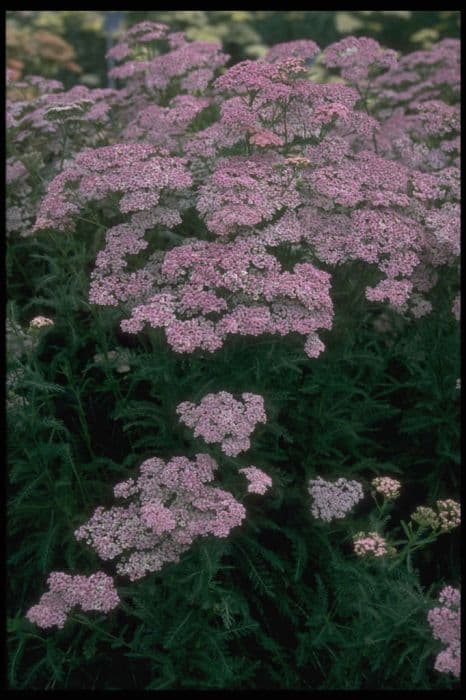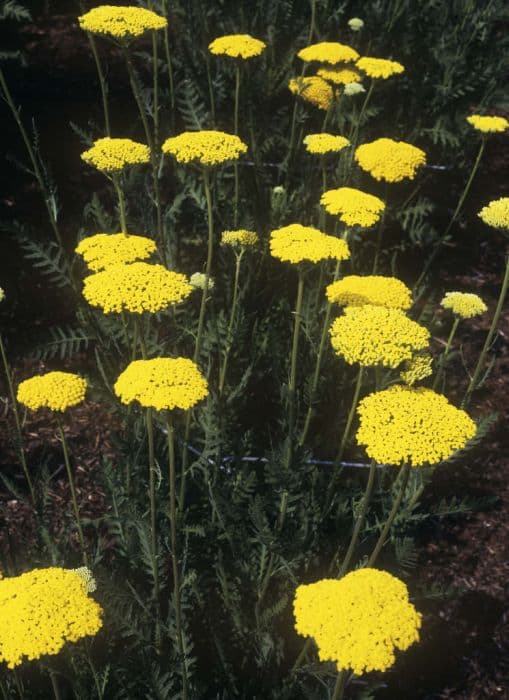Tickseed Coreopsis grandiflora 'Sunfire'
![tickseed [Sunfire]](/_next/image?url=https%3A%2F%2Fplants-admin.emdemapps.com%2Fimages%2Fplants%2F%2Fimages%2F604b5bc4f330a.png&w=3840&q=75)
ABOUT
Coreopsis grandiflora 'Sunfire' is a vibrant perennial known for its striking golden-yellow flowers that boast a contrasting deep red ring at their base, giving them a mesmerizing sun-kissed appearance. The flowers are daisy-like in shape, with a prominent central disk surrounded by slender, pointed petals radiating outwards. Often there's a frilled or slightly toothed texture to the petal edges, enhancing their cheerful demeanor. The bloom period of 'Sunfire' is notable for its length, often providing a showy display through the summer months. The foliage of this plant consists of narrow, lance-shaped leaves that are medium to dark green in color. These leaves are typically arranged in a dense, bushy manner along the stems and form an attractive mound, which serves as a lush backdrop to the bright blooms. 'Sunfire' has a tidy habit and its leaves often have a fine texture that adds to the plant's overall feathery and light appearance. The foliage contrasts well with the brilliant flowers, creating a spectacular effect in garden beds and borders.
About this plant
 Names
NamesFamily
Asteraceae.
Synonyms
Large-flowered Tickseed, Sunfire Tickseed, Tickseed Sunflower.
Common names
Coreopsis grandiflora 'Sunray', Leptosyne grandiflora.
 Toxicity
ToxicityTo humans
Coreopsis grandiflora, commonly known as Tickseed, is not known to be toxic to humans.
To pets
Tickseed is not known to be toxic to pets. However, it is always advisable to prevent pets from eating plants as individual animals might have sensitivity or allergic reactions that others do not.
 Characteristics
CharacteristicsLife cycle
Perennials
Foliage type
Deciduous
Color of leaves
Green
Flower color
Yellow
Height
1-3 feet (0.3-0.9 meters)
Spread
1-2 feet (0.3-0.6 meters)
Plant type
Herb
Hardiness zones
4-9
Native area
North America
Benefits
 General Benefits
General Benefits- Attracts Pollinators: Coreopsis grandiflora 'Sunfire' is known to attract bees, butterflies, and other beneficial insects that are vital for pollination.
- Low Maintenance: This plant is drought tolerant once established and does not require frequent watering, making it relatively low-maintenance.
- Long Blooming: It has a long flowering season, often blooming from early summer well into fall, providing extended color in the garden.
- Easy to Grow: 'Sunfire' is adaptable to a wide range of soil types and conditions, which makes it an easy plant to grow for gardeners of all levels.
- Bright Color: Its vibrant yellow flowers with a deep red center add a splash of color and can brighten up landscapes and gardens.
- Herbaceous Perennial: Being a perennial, it returns year after year, saving the cost and effort of replanting annually.
- Resistant to Pests: Typically, 'Sunfire' is resistant to deer and other garden pests, which helps ensure its longevity and beauty.
- Great for Cut Flowers: The flowers of Coreopsis grandiflora 'Sunfire' are suitable for cutting and make lovely additions to floral arrangements.
- Native Plant Benefits: As a native species, it supports local ecosystems and is likely to thrive in appropriate regions with less care.
- Landscape Uses: It's versatile for garden design, useful in borders, mass plantings, or as a specimen plant.
 Medical Properties
Medical Properties- This plant is not used for medical purposes.
 Air-purifying Qualities
Air-purifying QualitiesThis plant is not specifically known for air purifying qualities.
 Other Uses
Other Uses- Dye Production: Coreopsis grandiflora 'Sunfire', also known as Tickseed, can be used to produce a natural yellow dye for textiles, derived from its bright yellow flowers.
- Photography: Tickseed's vibrant flowers are often used as a subject for macro photography, helping photographers to capture the intricate details of its petals and center.
- Culinary Garnish: The petals of the Tickseed are edible and can be used to add a splash of color to salads and culinary presentations.
- Flower Pressing: Craft enthusiasts can press the flowers of Tickseed to create natural art pieces, bookmarks, or decorate homemade cards.
- Educational Tool: Tickseed plants are used in schools and educational programs to teach students about pollination and the lifecycle of plants.
- Craft Supplies: The dried flowers and seeds of Tickseed can be used in creating craft supplies such as natural confetti or potpourri.
- Skin Care: While excluding medicinal properties, the petals of Tickseed can be infused in oils for use in homemade skin care recipes for their soothing properties.
- Garden Borders: The bright and compact growth of Tickseed makes it ideal for creating colorful garden borders and edgings.
Interesting Facts
 Feng Shui
Feng ShuiThe Tickseed is not used in Feng Shui practice.
 Zodiac Sign Compitability
Zodiac Sign CompitabilityThe Tickseed is not used in astrology practice.
 Plant Symbolism
Plant Symbolism- Optimism: Coreopsis grandiflora 'Sunfire', commonly known as Tickseed, is symbolic of optimism due to its bright, sunny blooms that resemble the sun.
- Cheerfulness: The vibrancy and abundance of the flowers embody a spirit of cheerfulness, infusing joy into any setting.
- Love: Some traditions hold that Tickseed represents everlasting love, making it a popular choice for romantic bouquets and gifts.
- Good Health: The plant is also associated with good health, perhaps due to its hardiness and the fact that it blooms brightly even in challenging conditions.
 Water
WaterTickseed plants, including Coreopsis grandiflora 'Sunfire', prefer to be watered deeply and infrequently as they are relatively drought tolerant. It is best to water them when the top inch of soil feels dry to the touch. Providing about one inch of water per week, either from rainfall or by manual watering, should be sufficient. During the hot summer months or in particularly dry conditions, you may need to water twice per week. On average, this would mean using approximately 0.625 gallons of water for a square foot every week during regular weather conditions, adjusting as necessary for heat or drought.
 Light
LightTickseed thrives best in full sunlight, which means at least six to eight hours of direct sunlight per day. It should be planted in a spot that receives unobstructed sunshine throughout the day to ensure it grows vigorously and produces abundant blooms. If placed in too much shade, the plant may become leggy and produce fewer flowers.
 Temperature
TemperatureThe ideal temperature range for Tickseed is between 60 to 75 degrees Fahrenheit. They can tolerate a wide range of temperatures and are quite hardy, surviving minimum winter temperatures down to around -30 degrees Fahrenheit. However, temperatures exceeding 90 degrees Fahrenheit for prolonged periods may stress the plant, requiring occasional supplemental watering to keep the plant hydrated and healthy.
 Pruning
PruningPruning Tickseed is necessary to promote bushier growth and more blooms. Deadhead spent flowers regularly to encourage continuous blooming throughout the growing season. In late summer or early fall, lightly prune or pinch back the tips to help maintain the plant's shape and encourage a fall rebirth of flowers. An overall trim in late winter or early spring, cutting the plants back by one-third, will prepare them for the growing season ahead.
 Cleaning
CleaningAs needed
 Soil
SoilTickseed thrives in well-draining soil with a mixture of loam, peat, and sand. Aim for a soil pH between 6.1 and 6.5. Organic compost can be added to enrich the soil.
 Repotting
RepottingTickseed typically does not require frequent repotting. It can be repotted every 2-3 years or as needed when it outgrows its current container.
 Humidity & Misting
Humidity & MistingTickseed is adaptable to a wide range of humidity levels and does not have specific humidity requirements; average room humidity is sufficient.
 Suitable locations
Suitable locationsIndoor
Ensure full to partial sunlight and good air circulation for healthy growth.
Outdoor
Plant in a sunny spot with well-draining soil and space plants 12 inches apart.
Hardiness zone
4-9 USDA
 Life cycle
Life cycleCoreopsis grandiflora 'Sunfire', commonly known as Tickseed 'Sunfire', begins its life cycle when seeds are sown in late winter to early spring or when new plants are propagated through division. The germination stage follows, with seedlings emerging in warm soil conditions and developing their first set of true leaves. As the plant enters the vegetative stage, it establishes a strong root system and grows rapidly, producing a mound of foliage. Flowering occurs in the early summer to midsummer, with bright yellow, daisy-like flowers that attract pollinators. After pollination, the plant sets seeds, which mature and can be collected for propagation or naturally disperse to begin a new generation. In late autumn, the perennial Tickseed 'Sunfire' may die back to the ground, only to regrow from its root system the following spring.
 Propogation
PropogationPropogation time
Spring to Summer
Coreopsis grandiflora 'Sunfire', commonly known as Tickseed, is a popular perennial that can be propagated through different methods, but division is the most popular due to its simplicity and effectiveness. Division is best performed in early spring or fall when the plant is not in active bloom. To propagate through division, dig up the entire clump of the plant and gently separate the root ball into smaller sections, ensuring that each new section has a portion of the root system and several shoots. These divisions can then be replanted in well-drained soil, spaced about 12 to 18 inches (30 to 46 centimeters) apart to allow for growth. After replanting, water the new divisions thoroughly to help establish the root system, taking care not to overwater and cause rot. Division not only helps propagate Tickseed but also invigorates older plants that may have become woody or less prolific in the center.









